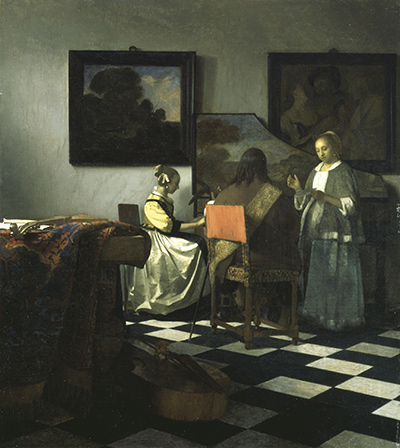Johannes Vermeer’s, The Concert is very much a painting of its time, yet possesses a beauty and potency that transcends the modern era.
It remains a great shame that the location of this work of art remains a mystery and as a consequence we are deprived of the opportunity of viewing it in all its glory.
The content of the painting reflects the Dutch tradition dating back to the early Renaissance where Dutch artists and painters used music as symbol of love and seduction.
Many paintings of this era were very “risqué” including those that form part of the Bordeclbjies (brothel scenes) genre. In “The Concert”, Vermeer’s approach is more subtle, however on closer inspection the sexual drama is present.
The sexual connection between music and the manipulation of musical instruments is further enhanced by the spirit of companionship, belonging and interaction between the male and female subjects of the painting.
Whilst the painting itself is not overtly sexual, there are signs within the painting that support this premise. One of the two paintings that is hung on the wall behind the subjects helps depict the sexual element of the picture.
The main focus of the picture is its three subjects who are as the title suggests playing a “concert” on their musical instruments. Whether they are alone and this is for their own gratification remains unclear as there is no audience depicted in the painting.
An audience may simply be out of view as the whole room is not displayed, however it remains more likely due to the sexual undertones that the gratification is personal to the three participants as it would be in a sexual environment.
The subjects themselves are beautifully painted, yet the man who appears from the shape of the headstock displayed to be holding a lute, is only shown form the back so it is impossible to interpret his mood.
The position of the subjects hands intimate that the music is being created and they are engaged in playing. There is an air of formality and innocence portrayed by the two women who are both smartly attired in traditional dress and appear well groomed.
There remains certain innocence to them. The sexual element of the painting becomes more obvious by the content of the painting shown on the wall to the right of the harpsichord.
This is the artist’s representation of a painting by another artist, The Procuress by Dirck Van Baburen. It is believed that this painting was owned by Vermeer’s mother-in-law and that it inspired him.
It was also featured in other Vermeer paintings. The sexual situation in this picture is direct, it represents two men engaged in conversation with a prostitute, with one man offering some coins in payment for her services.
The painting’s potency is heightened by the expression of the face of the girl and one of her customers, it may be considered lustful but equally portrays passion and empathy.
The use of this picture in the background corroborates the less obvious sexual tension displayed in the interactions between the three subjects and the then context of music in the creation of sexual drama.
The painting was thought to have been painted in 1664 and is one of only a few of the artist’s paintings to utilise less intense layers of colour. Later painting saw him layer brighter colours to create light and shadow.
The “light touch” of the paint application adds to the beauty and the almost nymph like innocence quality of the two women. Vermeer adds colour to his work, albeit subtly in the ornate painted lid of the harpsichord and a colourful throw that is draped over a piece of furniture towards the front of the aspect displayed in the painting.
The great shame is that the painting was stolen in a robbery at the Isabella Stewart Gardner Museum in 1990 and its location remains unknown. It is estimated that “The Concert” remains the world’s most valuable missing painting with a valuation in excess of $200,000,000. It can only be hoped that one day this painting is returned and the public can once again divulge pleasure from viewing it.




